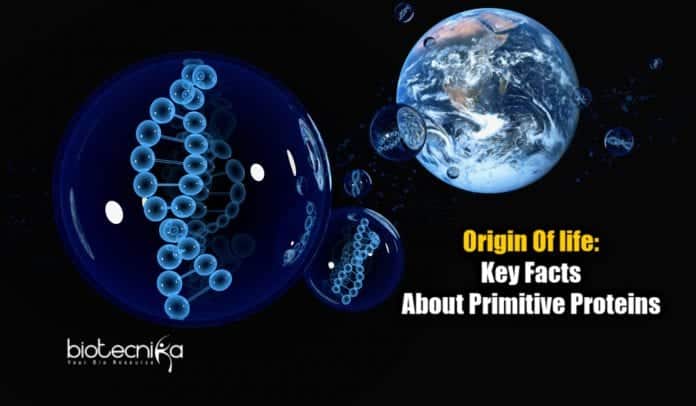A Possible Way Of Formation of Proteins During Origin Of Life
What did those proteins that appeared on Earth 3.7 billion years ago look like? Prof. Norman Metanis of the Hebrew University of Jerusalem and Prof. Dan Tawfik of the Weizmann Institute of Science reconstructed the proteins sequences that resemble those of ancestors of modern proteins. A way that these proteins could have progressed to form living cells is also suggested by their research work. The results were published in the Proceedings of the National Academy of Sciences (PNAS).
The screws, springs, and cogs of a living cell are the proteins encoded in a cell’s genetic material. And the proteins could have appeared well before the cells and life. Proteins are made of 20 essential amino acids, arranged as long chain-like molecules, in the form of a polymer. For a protein to function properly, the placement of each of these amino acids is crucial.
But the question of how the earliest proteins arose is complicated. Because the amino acids are themselves produced by other protein enzymes. So it’s a chicken-or-egg kind of question.
The very true proteins were materialized from shorter protein segments called peptides, say, scientists. The amino acids
that were spontaneously created in the primeval chemical soup assembled together to form sticky peptides, which then bound to one another forming a protein capable of some sort of action.The famous experiment by Miller and Urey in 1952 demonstrated the spontaneous generation of amino acids. They replicated in the laboratory, the conditions thought to exist on Earth before life existed and added energy similar to that which could have come from volcanoes or lightning. This experiment showed that the formation of amino acids could have happened without the help of proteins, enzymes, or any other mechanisms, under the right conditions in a living organism.
However, a vital type of amino acid was missing from that experiment and all the experiments that followed. Amino acids like lysine and arginine that carry a positive electric charge are important in modern proteins as they interact with negatively charged RNA or DNA. Interaction of RNA with positively-charged amino acids is crucial for the development of living cells.
In the Miller-Urey experiments, there was the presence of one positively charged amino acid called ornithine. It’s an amino acid found as an intermediate step in arginine production but cannot build proteins by itself. The researchers hypothesized that ornithine could be the missing amino acid in those ancestral proteins. To test this, an original experiment was designed.
To infer the sequence of the ancestral protein, the scientists applied phylogenetic methods to a relatively simple protein from a family that binds to RNA and DNA. 14 of the 64 amino acids in this protein is either lysine or arginine, making the protein, rich in positive charges. Then they created a synthetic protein in which the positive charge carriers were replaced with ornithine.
This synthetic protein bound to DNA weakly. However, simple chemical reactions under the conditions thought to have existed on Earth before life were able to convert ornithine to arginine. The proteins became more and more similar to modern proteins as more and more ornithine was converted to arginine. And they bound to DNA strongly.
The scientists also discovered that the ancient form of the peptide engaged in phase separation (like oil drops in water) in the presence of RNA. This can lead to “departmentalization” and self-assembly. This suggests that protocells from which true living cells might have evolved could have led to the formation of such proteins and RNA during the origin of life.






























